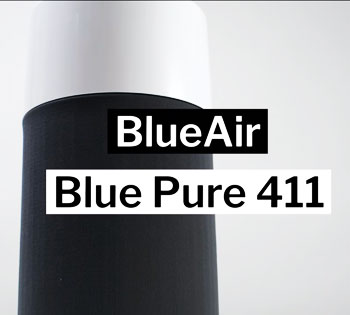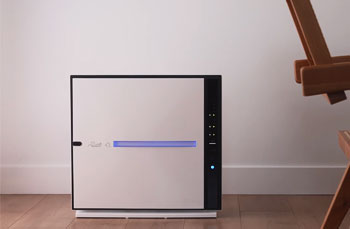With air quality being a growing concern, more people are looking to air purifiers to remove allergens, pollutants, odors, and more from their homes. Two popular brands known for their high-quality purifiers are Blueair and Rabbit Air.
But which one is better for your needs? We’ll compare the key features, pros and cons of Blueair and Rabbit Air purifiers to help you decide.
A Brief Comparison Table
| Feature | Blueair | Rabbit Air |
| Filtration | HEPASilent filter (HEPA + carbon) | Multiple filter options: HEPASilent, Activated carbon, BioGS HEPA, Ionizer, UV light |
| Room Coverage | 200 – 2,400 sq ft options | Up to 2,000+ sq ft options |
| Noise Level | 16 – 56 dB range | 17 – 60 dB range |
| Design | Sleek, minimalist | More variety – tower, box, wall-mount |
| Smart Features | App control, scheduling | Auto-detect, app control, scheduling |
| Cost | $400 – $1,000+ | $500 – $1,200+ |
| Filters | Only HEPASilent available | HEPASilent standard but other options available |
| Maintenance | Easy filter changes | UV bulb replacement annually for some models |
Overview Of Blueair And Rabbit Air
Blueair and Rabbit Air take different approaches when designing their air purifying products.

Blueair focuses on using their proprietary HEPASilent technology in all their purifiers. This filter combines activated carbon with particle filters to remove airborne pollutants.
Their filters are very effective at particle removal down to 0.1 microns. Blueair purifiers tend to have a simple, sleek Swedish design that maximizes filter surface area within the units. They offer several sizes for small to large rooms.
Rabbit Air takes a more comprehensive approach by offering a wider range of filter types in their units. While they do provide HEPASilent filters, they also have options like activated carbon filters, negative ion generators, and UV light sanitizers.
Their MinusA2 model even includes a bioGS HEPA filter that traps viruses and germs. Rabbit Air’s products come in a variety of styles, like towers, boxes, or wall mounts. This wider range of products and features allows consumers to better customize a unit for their needs.
Filtration Capabilities
The key element of any air purifier is its filtration system. This is the technology that actually cleans the air. Both brands use high-quality filters that are effective at removing a wide range of indoor pollutants.
Blueair Filters
All Blueair purifier models use their patented HEPASilent filtration technology. This combines mechanical filtration with activated carbon for adsorption of gases and odors. Their filters trap 99.97% of particles down to 0.1 microns in size, including allergens like pollen, smoke, dust, pet dander and mold spores.
Some Blueair models also offer Particle + Carbon filters which have an extra activated carbon layer for enhanced gas and odor removal. This includes volatile organic compounds (VOCs).
Rabbit Air Filters

Rabbit Air offers a few different filter types depending on the purifier model:
- HEPASilent – Similar performance to Blueair’s filters, removing 99.97% of 0.3 microns particles.
- Charcoal Activated Carbon – Adsorbs gases, odors, VOCs, and chemicals.
- BioGS HEPA – Proprietary filter designed to trap viruses, germs, pet dander, mold, bacteria.
- Negative Ion Generator – Emits negative ions that attach to particles and allergensto make them easier to filter.
- UV Light – Further sanitizes particles caught by the filter.
Both brands offer effective HEPA-based filtration that can capture most indoor air contaminants. Rabbit Air has a slight edge with their virus and germ-catching BioGS HEPA filter. Those concerned about bacteria and viruses may prefer this option.
Ease Of Use
When shopping for an air purifier, you want one that is convenient and easy to operate. Here is how Blueair and Rabbit Air compare when it comes to ease of use:
Noise Levels – Blueair and Rabbit Air both use whisper quiet designs. Blueair has trademarks on the phrases “HEPASilent” and “WhisperQuiet”. But independent tests show many Rabbit Air models operate at noise levels just as low, or lower, than comparable Blueair units.
Controls – Both have simple push button controls and optional apps to control the purifiers remotely. Rabbit Air offers more flexibility with the MinusA2 having auto, sleep, turbo, and eco modes. Blueair models do not have as many settings to toggle between.
Filters – Changing filters on both brands is a quick and simple process. Blueair filters only fit in one direction for foolproof installation. Rabbit Air has color coded filters that also only fit one way. Both have filters that can last 6-12 months depending on usage.
Maintenance – Very little maintenance is required other than periodic filter changes. The units automatically monitor filter status. Rabbit Air models with UV bulbs require annual bulb replacements.
Overall, Rabbit Air units tend to offer a few more conveniences, like multiple modes and voice control options. But Blueair still keeps operation very simple. Either brand is easy to use for most consumers.
Room Coverage
Air purifiers need to be the right size for the rooms you want to clean. Here is how Blueair and Rabbit Air compare in terms of coverage areas:
Small Rooms – Blueair’s Blue Pure 211+ and Rabbit Air’s MinusA2 700 cover rooms up to 700 sq ft. Excellent for bedrooms and home offices.
Medium Rooms – Blueair 480 and 480i and Rabbit Air MinusA2 800 work for bedrooms, living rooms, and dens up to 800 sq ft.
Large Rooms – Blueair 605 and Rabbit Air BioGS 2.0 have capacities for extra large spaces up to 1,500 sq ft. Great for open concept rooms.
Extra Large Rooms – Blueair Pro XL clears rooms up to 2,400 sq ft. Equivalent extra strength Rabbit Air models can tackle over 2,000 sq ft.
Both offer units suitable for small to very large spaces. Their capacities are fairly comparable across the different product lines. Those with open floor plans will appreciate the high-end models designed for huge rooms.
Smart Features
Modern conveniences like smart home connectivity and air quality monitoring are popular features of newer air purifier models. Here is how Blueair and Rabbit Air offer smart capabilities:
Connectivity – All Blueair models can connect to the Blueair app for monitoring and control. Rabbit Air MinusA2 models also connect to apps via WiFi. Lower-end Rabbit Air models lack app connectivity.
Real-time Monitoring – Blueair and Rabbit Air both provide real-time monitoring of air quality and filter status. The apps make it easy to check in on air quality from anywhere.
Alexa/Google Assistant – Select models from both brands can be controlled via voice commands. This allows for hands-free control.
Auto-Detect – Some Rabbit Air purifiers have sensors to automatically adjust fan speeds based on real-time air quality readings. Blueair units operate at a consistent fan speed.
Scheduling – Apps for both allow users to create on/off schedules. This allows for setting quiet times and creating operating routines.
For most smart features, Blueair and Rabbit Air are pretty evenly matched. The auto-detect function in some Rabbit Air models provides added convenience for automatically adjusting purification rates as needed.
Also Read: Is IQair Better Than Molekule?
Design
Purifiers come in a variety of shapes, sizes, and styles. Here is how the designs of Blueair and Rabbit Air models compare:
Blueair Designs – Sleek and minimalist. Most models use cylindrical or egg-shaped designs maximizing filter surface area. Neutral color schemes in white, grey, and black. Best suited to modern and contemporary decor.
Rabbit Air Designs – More variety offered. Tower, box, and wall-mount form factors. More color options like white, black, gold, pink, blue and “green”. Some models customized by major artists. Better fits with different aesthetics.
Size Options – Both offer compact units for small rooms and larger models for big spaces. Takes up a similar footprint.
Noise – Equivalent noise levels. Designed to blend unobtrusively into the background.
For those wanting a subtle design, Blueair’s minimalist style works beautifully. Rabbit Air offers personalization and blending for more styles. Either brand has quietly elegant options to suit different tastes.
Cost Comparison
Pricing can be a major factor when selecting an air purifier model. Here is an overview of how Blueair and Rabbit Air costs compare:
Small Units – Entry-level small room units are similarly priced. Around $400 for the Blue Pure 211+ Vs. $500 for the Rabbit Air MinusA2 700.
Medium Units – Blueair 480 series ($800) costs a bit less than the Rabbit Air MinusA2 800 ($900).
Large Units – The largest models go up to around $1,000 or more. Similar pricing.
Filters – Replacement filters for Blueair and Rabbit Air are comparable. Annual costs around $120 on average.
Electricity – Operation costs are minimal for both brands, especially on lower settings. Only pennies per day.
Overall, pricing is very competitive between the brands for units of similar capacities and features. Shoppers should comparison shop models with equivalent specs. Be sure to factor in ongoing filter replacement costs.
Summary Of Pros And Cons
Blueair Pros
- Proven HEPASilent filtration effective for particles
- WhisperQuiet operation
- Sleek simplistic Scandinavian design
- Smart features like app controls and alerts
- Covers a wide range of room sizes
Blueair Cons
- Limited filter type options
- Not personalized for style
- No auto-detect setting
Also watch this video!
Rabbit Air Pros
- Multiple filter options including BioGS HEPA
- Ultra customizable design and color options
- Auto-detect function on some models
- Slightly wider size range for extra large spaces
Rabbit Air Cons
- Pricing may run a bit higher than Blueair
- Entry models lack app connectivity
- Slightly more involved maintenance for UV bulb models
Frequently Asked Questions (FAQ)
Yes, Blueair makes excellent air purifiers. They use proven HEPA-based filtration technology and very quiet fan designs. Their focus is on maximizing filter performance. Blueair units will effectively reduce allergens, odors, smoke, dust and other irritants. Their simplistic style also appeals to many consumers.
Blueair units use HEPA filters. HEPA stands for “high efficiency particulate air” which is an industry standard type of filter rated to catch very small particles. Blueair combines HEPA filters with activated carbon for increased gas/odor removal. Their HEPASilent filters reliably meet strict HEPA filtration standards.
Rabbit Air is considered one of the main competitors and alternatives to Blueair purifiers. Other brands like Austin Air and Iqair also offer comparable high-end HEPA purification systems. Consumers should compare the designs, capabilities and prices across brands to find the best option for their needs and budget.
The main competitors for Rabbit Air include Blueair, Austin Air, Iqair and Oransi. These all provide high-performance HEPA air purifiers for whole home use. Other competitors in the more general market include Honeywell, LEVOIT, Winix and Coway. Each brand has their own approach to product design and features.
Also Read: Differences Between Rabbit Air And Coway.
Conclusion
Blueair and Rabbit Air both make exceptional air purifiers that effectively clean the air using advanced filtration. Those focused purely on particle removal may prefer Blueair for their undivided focus on HEPA filtration.
For consumers wanting more filter customization or style personalization, Rabbit Air is an excellent alternative. Either brand offers whisper quiet operation, impressive cleaning power, and smart convenience features. By comparing the key factors covered here you can decide whether a Blueair or Rabbit Air purifier better matches your purification needs.
